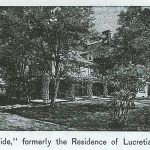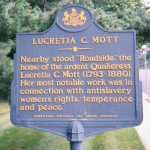Roadside
In 1857 Lucretia Mott and her family moved from Philadelphia to a farm in Cheltenham known as Roadside. It was situated near Old York Road where Latham Park is located. At the time it was part of an estate called Old Farm purchased years earlier by her daughter Marie and her husband, Edward M. Davis an important land developer in the area.

“Old Farm extended from Old York Road to Penrose Avenue and from City Line (Cheltenham Avenue) to Beech Avenue. Lucretia Mott lived at Roadside, a three-story stone building with an ivy-covered porch, until her death in 1880. The following year her daughter sold the house to Edward M. Wister. The developer of Latham Park, Taylor Blake Roberts, acquired the property in 1912 and demolished the house that many residents strongly feel should have been left standing as a symbol of Cheltenham’s contribution to the Civil War.”

“Roadside was not the hectic delegate-filled household that their house in Philadelphia had been, but it became, instead, a stopping place for a different kind of traveler. The Motts were active in the establishment of the Underground Railroad, and enthusiastically they provided a station at Roadside. However brief their pause at Roadside, fugitive slaves always found the comfort and reassurance they needed to continue their escape to Canada and freedom.
This activity continued during the Civil War until the slaves of the southern states were granted their freedom under the Emancipation Proclamation. The date it became effective was January 1, 1863, which Lucretia Mott described as “a day of jubilee.” Many abolitionists joyously pronounced that they were “out of business,” but others, like Lucretia Mott, knew that the business of securing equality for all Americans was far from complete.”
Cheltenham Township Where Growth is a Tradition
Nancy Gibson, P.I.O., Cheltenham